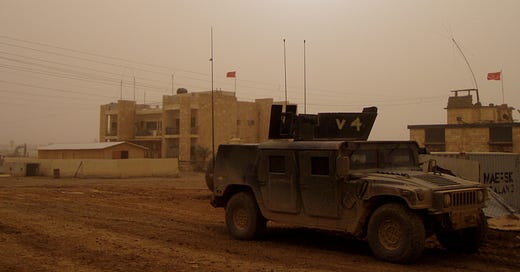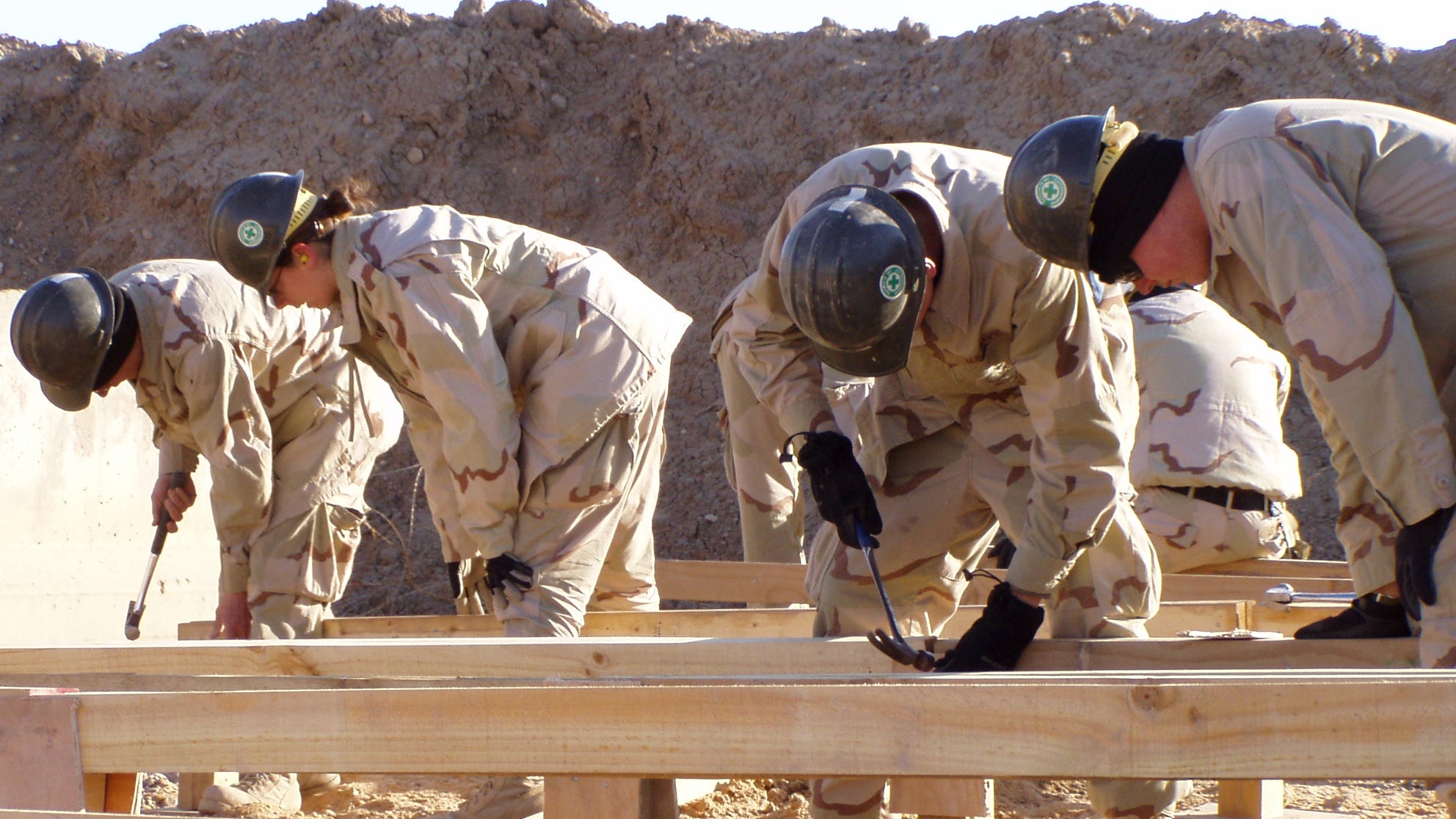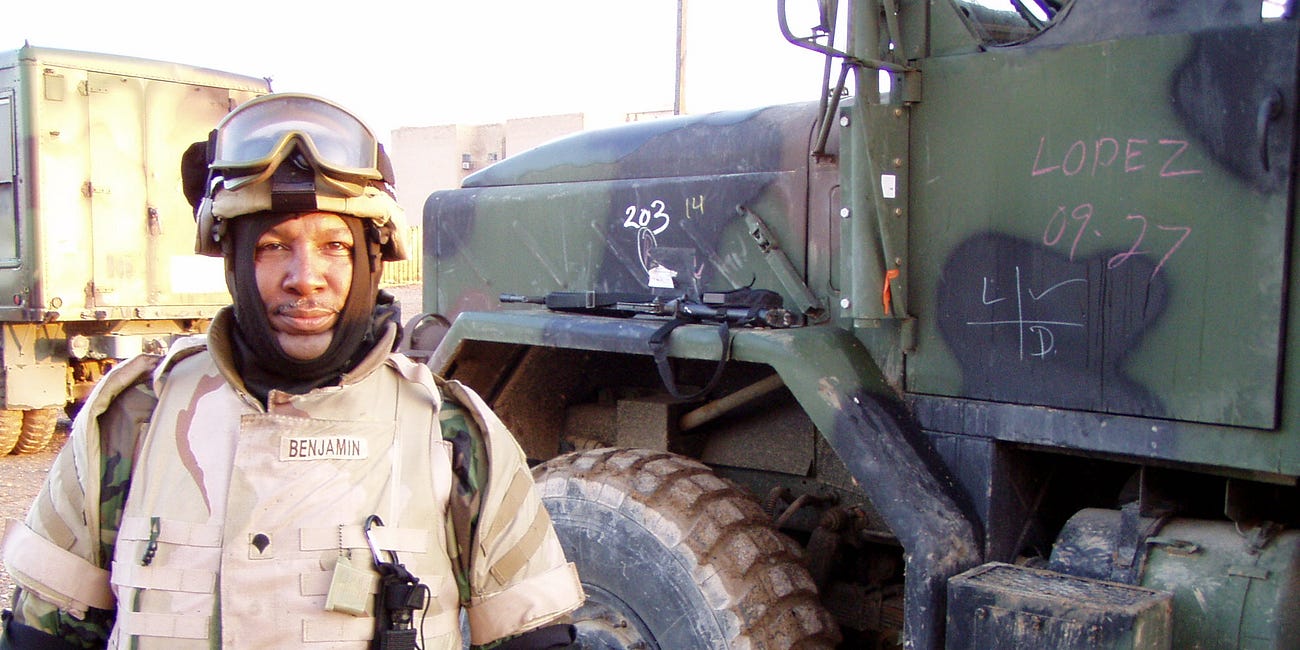Between February 2005 and March 2006, I traveled to Iraq several times for The Village Voice—the New York City alternative newspaper that folded in 2017 and now reappears only sporadically. I wrote 16 stories for The Village Voice. The paper paid me $1,000 for each, essentially launching my writing career.
My last story for The Village Voice appeared in March 2006. It was about a band of U.S. Navy Seabees who were trying to rebuild a dilapidated base in Iraq shortly after Hurricane Katrina destroyed their own homes back in the United States. I’ve reprinted it below.
It’s a slow day at the U.S. military base outside Ar Ramadi in Iraq’s western province of Al Anbar in March 2006. The local bad guys shot their load two nights ago with a midnight mortar barrage that sent resident Marines, soldiers and Navy Seabees scurrying for cover.
The morning was freezing cold and wet and the following night first too windy then too foggy for helicopters, the preferred mode of transportation, to get in or out. “Worst. Desert. Ever,” is how some U.S. troops describe Iraq’s winter wonderland. Regular rains and deep chills turn much of Iraq into a swamp for weeks at a time.
So there’s not much going on at Ar Ramadi—which, in the culture of the Navy’s construction battalions (or “CBs”, from which the “Seabees” nickname derives), is an intolerable state of affairs. As if spontaneously, a dozen sailors in hard hats converge on a bare patch of muddy gravel and, within hours, have hammered together the frame for a brand-new barracks.
It’s not really necessary—there’s a vacant barracks right next door—but it’s something to do. Chief Steelworker Michael Romero, one of the senior Seabees at Ar Ramadi, explains that his unit doesn’t like sitting around.
Not that they get many opportunities to do so. The U.S. military is slowly turning Al Anbar into a permanent outpost, with two major airfields at Al Asad and Al Taqaddum and around a dozen smaller bases. That means plenty of work for the 650 men and women of Naval Mobile Construction Battalion 133 from Gulf Port, Mississippi.
In the early months of 2006, the Iraq war is entering a new phase. Coalition troops are converging on a shrinking number of large well-equipped bases in remote areas while Iraqi forces, for better or worse, take over the smaller posts in the cities and towns and assume responsibility for day to day security.
Increasingly, U.S. forces are playing a supervisory and quick-reaction role, training up ragtag Iraqi forces and coming to their aid when they get in over their heads against well-armed insurgents.
The upside of this trend is that U.S. enclaves are bigger and therefore more secure than ever and the troops exposed to less danger. The downside is that poorly-trained and equipped Iraqi forces are incapable of providing the same degree of security in restless cities like Al Anbar’s Ar Ramadi, Fallujah and Habbaniyah.
Inside the American cordon, it’s safe to walk around in shirt sleeves and flip flops, weather permitting. Outside, it’s so dangerous that entire towns are all but off-limits to U.S. forces. And getting from one base to another, even over a distance of just a few miles, requires the Marines’ ancient and oft-grounded helicopters or a heavily-armed ground convoy.
And that really grates on Senior Chief Bob Crandall, boss of the Seabees detachment at Al Taqaddum, across Lake Habbaniyah from Ar Ramadi. He says the Seabees are happiest on humanitarian projects. “But here you don’t get out into the civilian community much. When the security situation improves, that might change. I don’t know.”
On previous six-month deployments to Iraq (this is 133’s third), the battalion restored an old British military cemetery and rebuilt around a dozen schools. They felt like they were doing some good for Iraq’s peoples. Now, they just work on the bases.
It’s not that their work’s not important. At Ar Ramadi, Romero’s detachment just finished a fortified chow hall serving 4,000 meals a day. An attack on a dining facility at a U.S. base in Mosul in 2004 killed more than 20 people. That plus the frequency of mortar attacks at Ar Ramadi got local commanders worried and resulted in this, surely one of the toughest cafeterias in the world.
Rather than the single large dining room of most military facilities, the Ar Ramadi chow hall has seven narrow crisscrossing tunnels supported by thick wooden beams. The walls are wood paneling over several feet of dirt and wire mesh. The ceilings are earthen, too, and can resist a direct hit by an insurgent mortar, Romero says. “Not that I’m eager to test it.”
For Romero, the project is personal. His friend Joel Baldwin was killed in the Mosul attack.
Elsewhere in Al Anbar, the Seabees build barracks and kennels for military dogs, patch up bases’ decaying Iraqi wiring and plumbing and prepare for some massive runway repairs at Al Taqaddum, a project that will see many of 133’s scattered detachments converge on the remote air base.
At Al Taqaddum, a constant stream of chartered and military cargo aircraft stitches the sky. There are growling Soviet-era propeller planes, buzzing Air Force Hercules transporters that spit incandescent flares to foil insurgent missiles and rickety Marine Corps helicopters that arrive in pairs with escorts of sharp-ended Cobra gunships.
Squinting into the sun at a passing helicopter, Electrician Charles Jacobs cites a litany of problems with the infrastructure at this airfield that was once home to Iraqi air force bomber squadrons.
Jets flying from Al Taqaddum dropped chemical weapons on Kurds. Now the same aircraft lie derelict near the Seabees’ corner of the base, their windscreens clouded over, their tail guns rusting, their bomb bay doors swinging impotently. The electrical grid is only a little better off.
“Electricity here is a mess. It’s a disaster,” Jacobs says. “We do what we can to make it operational.” Even so, he adds wanly, “we maintain a lot of generators.”
The fundamental problem with Al Taqaddum’s infrastructure is the same as in all of Iraq. The wiring, plumbing and pavement is crap. It was crap when it was new 30 years ago and there’s been virtually no investment since.
But Jacobs, like every Seabee, is no stranger to difficult conditions. In late August, just a month before 133 deployed to Iraq, its home station of Gulf Port was demolished by Hurricane Katrina. The battalion spent weeks clearing roads, handing out relief supplies and repairing homes—even some of their own.
Jacobs’ $200,000 house was destroyed, but he considers himself lucky. He was insured. Plumber Keith Lefebvre, who shares an office with Jacobs, lost his house, too. Lefebvre was uninsured.
“I’m starting over,” Lefebvre says, grimacing.
Deploying in the middle of their own personal disasters has been hard for 133. And worsening security in Iraq has kept them from the humanitarian missions that are their true calling. But theirs is frustration shared by the many Americans in Iraq whose best intentions are thwarted by this unforgiving land.
In Ar Ramadi, the sun peeks through the gray sky, warming the hard-working Seabees below. Setting aside their tools, the Seabees crack open a brand-new football from its box while Romero scurries around scrounging steaks for an afternoon barbeque.
Something rips through the air and, for an instant, everyone freezes. A mortar round explodes nearby and a truck burns. Into a concrete shelter Romero and his Seabees pile while, around them, bombs punch the cold mud.
Read more:
Second Stringers
Between February 2005 and March 2006, I traveled to Iraq several times for The Village Voice—the New York City alternative newspaper that folded in 2017 and now reappears only sporadically. I wrote 16 stories for The Village Voice. The paper paid me $1,000 for each, essentially launching my writing career.







